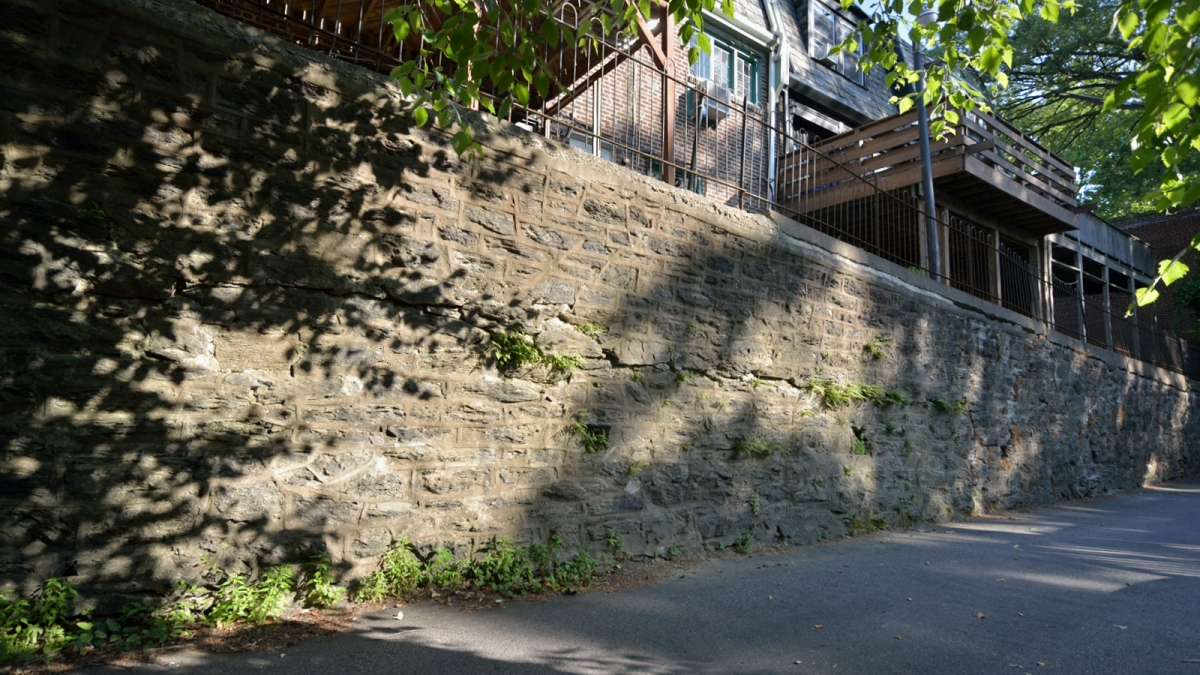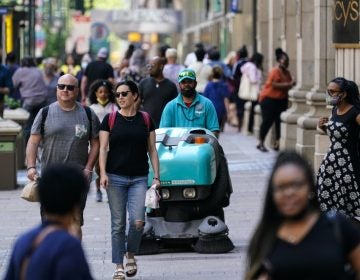$500K in repairs needed on East Falls retaining wall reflects citywide problem

The 550-foot stone-masonry retaining wall that separates the rear alley of houses along West Penn Street from the common driveway of homes along Midvale Avenue is leaning, cracked and unsafe. (Bas Slabbers/for NewsWorks, file)
Sections of a 550-foot-long retaining wall in East Falls built in the late 1920s are leaning, cracked, and unsafe, affecting the owners of 65 homes on either side of the wall.
Sound like an extraordinary situation? Not in Philadelphia.
There are 78 common walls in communities across the city with similar problems, in need of a total of $22 million in repairs. But there is no funding to fix them.
“We don’t have a specific solution for East Falls. What we need is a solution citywide,” according to Streets Commissioner David Perri.
The stone-masonry wall in East Falls separates the rear alley of houses along 3401-3463 W. Penn St. from the common driveway of homes along 3400-3458 Midvale Ave. Fissures are visible between the alley and the wall, and plants are growing in deteriorating parts of the mica schist and cement. If the wall falls, the rear decks of Penn Street homes will collapse and cause structural damage to those houses, a structural report by the Street Department found.
The Department of Licenses & Inspections sent a letter to residents in June informing them that they were in violation of building codes because of the condition of the wall. The residents have since been told that the situation does not pose an imminent threat to their safety and the violations have been rescinded while the city seeks a solution to the problem there.
But the situation in East Falls, which will take an estimated $500,000 to shore up, wouldn’t even make the top-ten list of worst common walls in the city, Perri said.
Geographic issues
Most of the deteriorating walls were built 60 to 100 years ago and were created so that developers could build level lots, backyards and parking areas in a city where elevation differs 450 feet from the lowest land to the highest spots, from the geographic distinctions of coastal plain to piedmont. The neighborhoods where this practice has resulted in the most problems are the hilly West and Northwest sections of Philadelphia.
When the walls needed repairs in past decades, the private owners of the properties that abutted the walls were held responsible for the costs. The city often hired a contractor for the reconstruction or repairs, then assessed the homeowners to reimburse the city based on their potion of the wall.
“It was done that way for years,” Perri said, “and it worked. But that model ran out of gas in the late 1960s.” The crumbling walls affected residents who could not afford to pay for the repairs, while the cost of the work increased. It became impossible for contractors to recoup their expenses, and “that model broke down.”
More recent attempts to deal with the common walls arose in the 1970s, when bonds were floated as part of the Neighborhood Transformation Initiative. About $2 million was spent through NTI bond proceeds to repair retaining walls from 2003 to 2007, Perri said. When that money ran out, the work on the walls stopped.
New approaches
The city is now seeking new mechanisms to fund the repairs.
“These issues really hurt neighborhoods if they stay in disrepair. They damage property values. The problem needs to be looked at with a holistic solution,” Perri said.
What is needed is a long-term model, one that can address retaining walls as well as issues like common driveways that have “reached the end of their lifecycles,” he continued.
Property owners can take it upon themselves to do the repairs, and that has occurred on a small scale in some neighborhoods, Perri said.
The second possibility would require the city to find sufficient funds to hire contractors to make the repairs and develop a repayment program for affected residents.
Those approaches are being considered by the Streets Department in concert with the city’s law and transportation departments. A model has been created by the Water Department, which helps residents by repairing sewer laterals and providing loans that residents can repay over the course of several years.
Another solution could involve adding a surcharge on real estate taxes of affected properties “to create a fund to pay for repairs over time,” Perri said.
Homeowners associations could also supervise payments on a regular basis to cover work on retaining walls and other property. “That’s the new model,” Perri said, “the mechanism for handling common assets.”
PlanPhilly is now a project of WHYY/NewsWorks. It began in 2006 as an initiative of Penn Praxis inside the University of Pennsylvania School of Design. Though now part of WHYY, PlanPhilly still works closely with Penn Praxis in covering planning, zoning and development news. Contact Alan Jaffe at ajaffe@planphilly.com.
WHYY is your source for fact-based, in-depth journalism and information. As a nonprofit organization, we rely on financial support from readers like you. Please give today.






